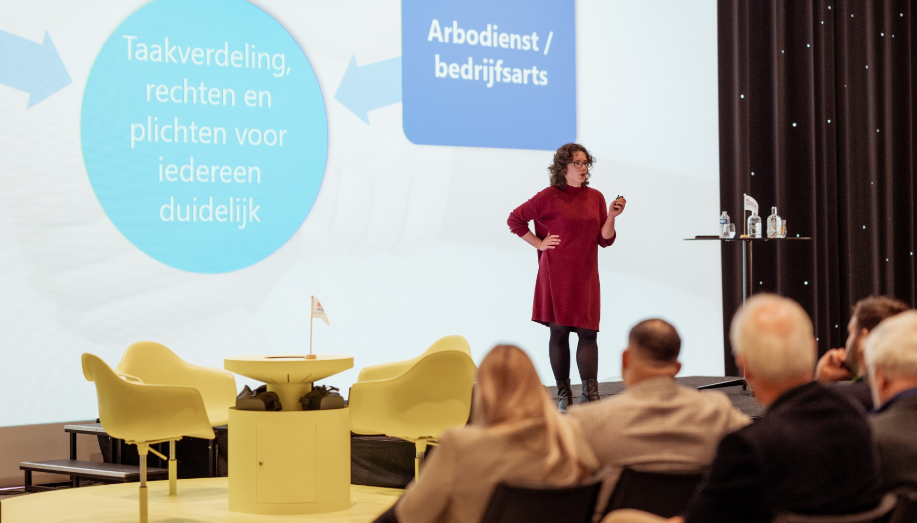With the introduction of the HR Risk Analysis, Schouten Zekerheid offers companies a practical method to identify and address challenges around absenteeism. Senior consultant André Hackmann and sustainable employability consultant Brenda van Dijk explain how this new service works. "We want to connect and solve," says Hackmann.
Schouten Zekerheid is an independent insurance broker and risk management consultant. With the new HR Risk Analysis service, they are an extension of the HR department, together fulfilling the crucial role of gaining insight into exactly where absenteeism is in an organization and directly reducing its costs. Everything revolves around the vitality and engagement of individual employees and teams. With the tightening labor market and increasing work pressure, it is essential that companies gain insight into this. That is why the HR Risk Analysis was developed. "Not many companies have good insight into their absenteeism rates," says Hackmann. "We offer in-depth, clear insights. But, just insights are not enough. We offer comprehensive insights, with solutions. Only that has real impact."
HR Risk Analysis: the roadmap
The HR Risk Analysis is a structured approach to identifying absenteeism. The process involves a comprehensive analysis of data. "We can map to the deepest level where absenteeism is," Hackmann says. "We measure absenteeism rates, but we also look at reporting frequency." Reporting frequency is the number of sick days compared to the number of people who are working. But you also have frequent absenteeism: how often does someone absent individually? "If someone absents five times in a year, for example, then something is going on. On average in the Netherlands, the reporting frequency sits at 1.39 times," Van Dijk said. A high reporting frequency and a high frequent absenteeism rate are indicators of long-term absenteeism and, if nothing is done about this, also increased risk of entering the WGA.
The team brings in a lot of different data. "With our tooling, you can look at absenteeism rate and reporting frequency. You can select by department level or age category or employment or any other criterion. You can easily cross-reference that way," van Dijk says.
But it goes deeper than that: "We also look at the culture. Have there been takeovers? Are people happy with their manager? That all shows up in the numbers. We discuss the standouts."
Analysis of risks
Based on the data collected, the team conducts a thorough analysis. They look at the people behind the numbers. Says Hackmann, "We have the belief that if we focus on the three least performing parts within a company and we go deeper there, engage in conversation there, then we create impact for the total organization." The tool developed by Schouten Zekerheid maps out where the pain is. "That's not just in things like 'you need to get your absenteeism rate down,' we go much deeper into the organization. As a result, you know much better what interventions and what to focus on." At the three units where the reporting and absenteeism rates are the highest, they engage in discussions with the manager, board members, directors and employees. Discussions are held in the areas of engagement, health and vitality. Van Dijk: "How are you doing, what could be better? What is going well? We engage in a very open conversation, there is attention for the individual employee."
Custom advice
Based on the comprehensive analysis, Schouten Zekerheid provides a plan with recommendations and action items to address the identified risks. Hackmann: "From the report comes an action plan. The numbers, the salient points, call for actions." The emphasis is on collaboration: "We really do it together with the company," van Dijk emphasizes. "We don't tell you to do something, we give advice. We look at how we can use an action plan to help clients/ get departments moving. We look at what is already at an organization and how you can make better use of that, or deploy it differently, to address your absenteeism." An action can start as simple as this: people are no longer allowed to call in sick via WhatsApp, for example. The actions basically lie with the directors and managers. "We have an overall action plan, where we actually push all the buttons," says Hackmann. "But we also have action plans for the different layers in a company. The steering has to come from the top and the change from the bottom It's nice that from the sessions with employees you get information from the bottom and from the top, so everything comes together."
Success story at Parnassia
The senior consultant and sustainable employability consultant talk enthusiastically about a successful approach with the HR Risk Analysis at Parnassia, a healthcare facility focused on mental health. "At the beginning, I asked Parnassia, 'What do you need? What is your biggest problem?' Once we had that very clear picture, we built a product." This tool is a combination of data and a model that already existed, but rebuilt and made its own by Schouten Zekerheid.
"At Parnassia, for example, you see a large influx of new employees. The figures show that employees on fixed-term contracts have the same reporting frequency after a year as employees on permanent contracts. You can see from the data specifically what young people are doing, but also the older employees. What is happening at different levels and departments? You can really see everything. At Parnassia, we have a goal of reducing absenteeism by ten percent. That's one and a half million savings a year for this business unit." Van Dijk: "This has actually just been a really nice great starting position for our HR Risk Analysis. We are also quite happy that Parnassia also just has the faith in us."
The results of the analysis and inventory provide a clear plan of action with clear guidelines. We are now putting these into action at Parnassia. "It gave them not only insight, but also confidence in the future," Van Dijk said.
Resistance and solutions
The sustainable employability consultant recognizes that there is also plenty of resistance to these types of projects. "We try to connect chains within a company. Of course we see resistance; 'yet another party that is going to deal with absenteeism.' Companies don't like dealing with that and we understand that. What we want to achieve is that even though they don't like it, they do see the effect. We have already seen this in one division at Parnassia. They have started steering on reporting frequency and you see improvement there. That's very interesting. That's how we try to link everything together."
After Parnassia, Schouten Zekerheid is taking the next step: the broad rollout of the HR Risk Analysis. "Companies may think: 'I already have an HR department, all kinds of specialists and interventions, I actually already have everything. Including numbers,'" Hackmann explains. "But how do you connect all that together? Plenty of companies have been dealing with absenteeism for years, have had interventions, but have never been able to grasp it. We can and we don't let it go. We are a resource. We grasp it, work on it together and set a new measure."
The consultants agree, "We have learned what works and where organizations benefit most in terms of absenteeism. Our goal is to help even more companies proactively manage their workforce risks."
André Hackmann, senior consultant Employee Benefits and Brenda van Dijk, consultant sustainable employability at Schouten Zekerheid



